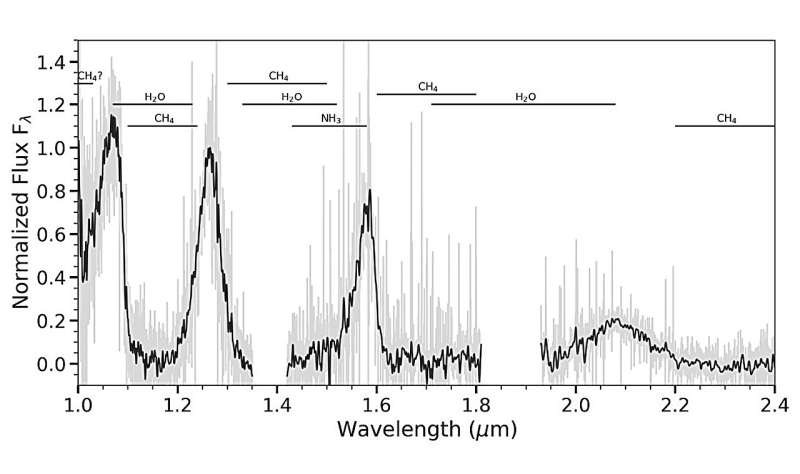
Keck/NIRES near-infrared spectrum for CWISE J105512.11+544328.3: original spectrum (gray) and 5-pixel smoothed spectrum (black). The spectrum is normalized to the J-band peak between 1.27 and 1.29 µm. Credit: arXiv (2023). DOI: 10.48550/arxiv.2310.09524
Using the Keck II telescope, astronomers have performed near-infrared spectroscopic observations of a nearby brown dwarf known as CWISE J105512.11+544328.3, or W1055+5443 for short. Results of the observational campaign, presented October 14 on the pre-print server arXiv, reveal that this object belongs to the rare class of ultracool brown dwarfs, dubbed Y dwarfs.
Brown dwarfs are intermediate substellar objects between planets and stars with masses below the hydrogen burning limit—about 80 Jupiter masses. One rare subclass of brown dwarfs, with effective temperatures lower than 500 K, is known as Y dwarfs. They are the coolest and least luminous substellar objects so far detected.
W1055+5443 is a brown dwarf at a distance of some 22.5 light years, discovered in 2012 and initially classified as a T dwarf (a subclass of brown dwarfs with effective temperatures between 500 and 1,500 K). However, new observations made by a team of astronomers led by Grady Robbins of the University of Florida, suggest that the object should be reclassified as a Y dwarf. The finding is based on the data collected with the Near-Infrared Echellette Spectrometer (NIRES) on the Keck II telescope.
“Near-infrared spectral analysis is so far the most effective method for classifying late T and early Y dwarfs, as they are very faint in the optical,” the researchers explained.
The observations found that W1055+5443 has an effective temperature of about 500 K and an absolute magnitude of 15.18 mag. These results indicate that W1055+5443 is most likely an early Y dwarf rather than a late T dwarf.
Moreover, the team found that the spectrum of W1055+5443 shows strong ammonia absorption plus methane and water absorption in the H-band, what further supports the Y-type classification. The astronomers added that the brown dwarf showcases an anomalously high H-band peak amplitude.
The study also found that the K-band flux of W1055+5443 is surprisingly high. According to the authors of the paper, the K-band spectrum of this object appears better matched to that of a mid-late T dwarf rather than a Y dwarf, yet it is still not a perfect match. The tangential velocity of W1055+5443 was estimated to be at a level of 50 km/s—therefore relatively high when compared to the solar neighborhood median value for brown dwarfs.
The astronomers noted that the unusual properties of W1055+5443 may be explained by a previously undetected companion object. However, based on the available data and binary modeling performed by them, they excluded this possibility.
Summing up the results, the scientists concluded that W1055+5443 is of spectral type Y0. They propose further observations of this brown dwarf as many of its properties like age or mass are still undetermined.
More information:
Grady Robbins et al, CWISE J105512.11+544328.3: A Nearby Y Dwarf Spectroscopically Confirmed with Keck/NIRES, arXiv (2023). DOI: 10.48550/arxiv.2310.09524
Journal information:
arXiv
© 2023 Science X Network
Citation:
W1055+5443 is a Y-type brown dwarf, observations find (2023, October 24)
retrieved 24 October 2023
from https://phys.org/news/2023-10-w10555443-y-type-brown-dwarf.html
This document is subject to copyright. Apart from any fair dealing for the purpose of private study or research, no
part may be reproduced without the written permission. The content is provided for information purposes only.
>>> Read full article>>>
Copyright for syndicated content belongs to the linked Source : Phys.org – https://phys.org/news/2023-10-w10555443-y-type-brown-dwarf.html
